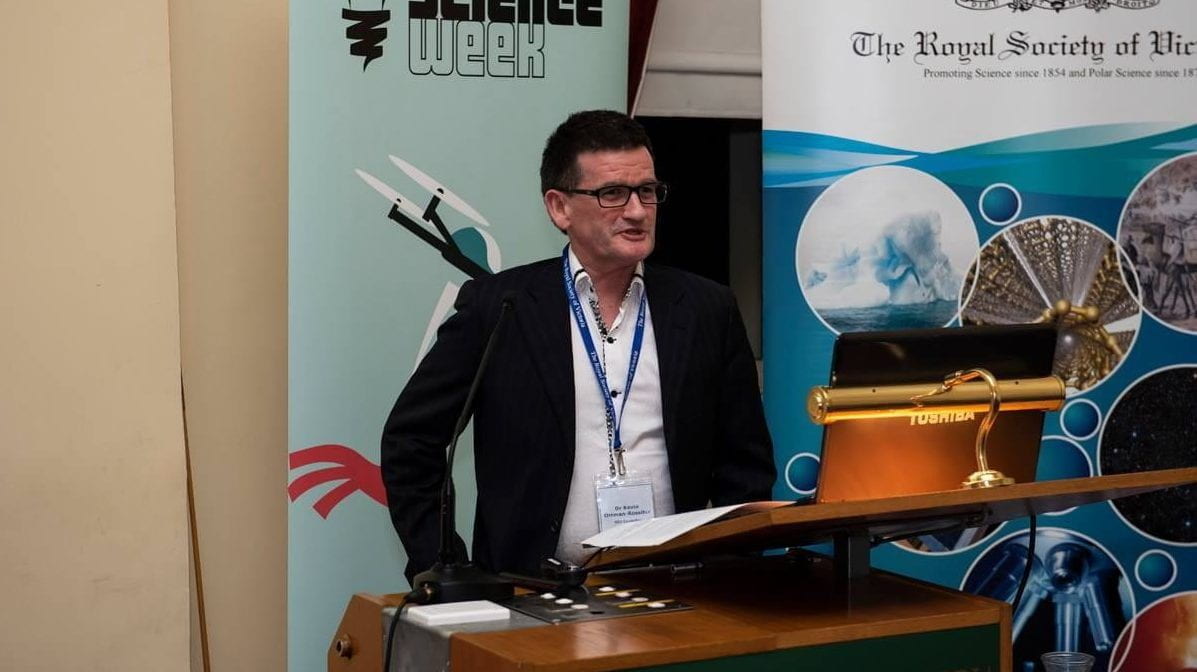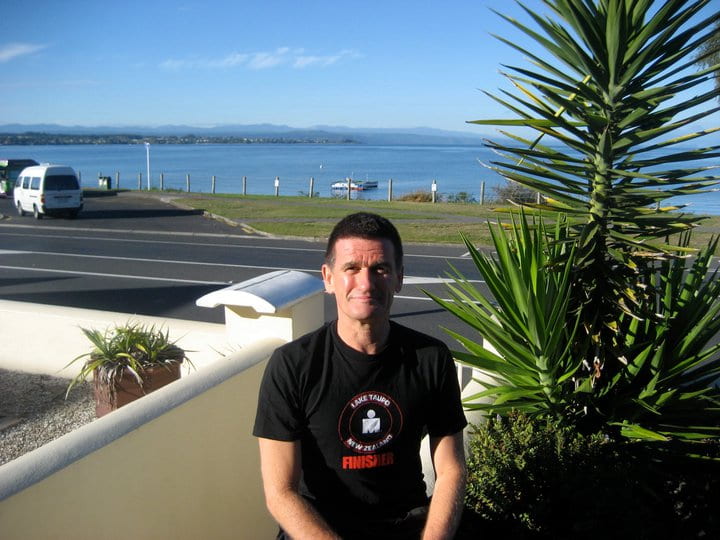
Exploring the History of Antimatter
Kevin Orrman-Rossiter is an unusual PhD candidate. Having completed a PhD in Physics early in his career, he is now immersed in a second PhD in History and Philosophy of Science (HPS) looking at the history of antimatter focusing on the positron, the antiparticle of the electron. In conversation with Samara Greenwood, Kevin describes what led him to this research and his project aimed at writing a ‘biography’ of the positron and its antimatter siblings.
What brought you to study History and Philosophy of Science?
Originally, I studied physics and I was a physicist. However, I was always interested in the philosophical side as well.
While I started out in academia, I later left to work in research and industry, and then in marketing and strategy.
Around that time, I decided that I had lost my ability to think. I was spending my entire life in a business environment where everything is about policy. So, I started doing philosophy at Monash University part-time and then realised what I was really interested in was philosophy and history of science.
When I got a professional role at Melbourne University, I took the opportunity to also do a Graduate Diploma in the History and Philosophy of Science and loved it. It was exactly what I was looking for.
While I enjoyed the studies, I really wanted to write and research and that led onto the PhD. I like the thinking and getting into the detail of something and pulling it apart and trying to understand it.
How did you choose your topic – researching the history of antimatter and the positron?
That’s an interesting question, and the honest answer is, I’m not really sure! It wasn’t something either of my supervisors, Dr Kristian Camilleri or Dr Gerhard Wiesenfeldt, suggested.
I think I had in the back of my mind that I didn’t really understand antimatter and I thought that would be an interesting subject. I floated the idea with my supervisors, and they thought that would be exciting.
When I was still an undergraduate physics major, I worked one summer at the Australian Atomic Energy Commission in Sydney as a student research assistant. I worked on an antimatter project. They were excited because I was a physicist and so they assumed I would know all about antimatter. I did an analysis project, and it was really interesting, but it also left me with a sense that I had no idea what I was doing! So, I think there was a joining together of my past and present, which then emerged into a PhD.

You have described your project as ‘A Biography of The Positron and its Antimatter Siblings’ – could you expand on what you mean by that?
Usually, when you do history of science, you talk about scientists or you pick a particular era. What I am trying to do is pick an object and treat it like a person.
So, people write biographies about Napoleon, for instance, and give the story a nice narrative arc of what he did and how he did it. Instead, I have picked an object called antimatter and I am following it through our human history. When did we first discover it? How did we use it as a tool to do other work? What is its later life?
I describe the history of antimatter as going through different phases; its discovery is like childhood, its development is like adolescence, and then there is its mature phase, where it is used as a tool for other things, like in medicine, and experiments at CERN.

For example, if you have ever come across PET scans [Positron Emission Topography] in a medical setting, they use positrons to check for diseases in your body.
I am following the biography of the actual object and treating it as an historical object.
What are the most interesting things to come out of your research so far?
I am finding there are two stories.
If you ask the physicists about antimatter, they immediately tell you the physics story, which is: at the start of the universe, equal amounts of anti-matter and matter were created, and then we have lost track of the anti-matter. And that is a really big physics conundrum.
Instead, I am telling the story from the perspective of: when did humans first think about anti-matter and discover it?
I find that interesting, that there’s actually different stories to describe the same thing.
Also, I’ve realised there are a series of different ‘discovery stories’ in what I’m looking at, and they don’t fit any nice, neat, single idea of a ‘discovery process’.
For example, the first bit of antimatter was discovered accidentally. The positron, which is an anti-electron, appeared in photographs when Carl Anderson was looking at cosmic rays in the early 1930s.
So, there is a nice discovery story exploring how something unexpected came up and how scientists were confronted with a new particle, rather than some experimental artefact. They then had to come up with theories to explain what it was.
However, there was already a theory proposed a few years before that said there should be anti-electrons and anti-protons. It was a bit of a throwaway story from a theoretician called Dirac. He was very famous and very bright and received a Nobel prize. However, he nearly didn’t get the Nobel prize because his theory of antimatter seemed just too farfetched. Nobody actually believed it, but then, all of a sudden, someone else discovered it.
So, here is this predicted discovery by Dirac, which everyone initially ignored. Then, after the photographs, the experimentalists accepted antimatter fairly quickly, but the theoretical physicists only accepted it two or three years later, after they came up with the supporting theory.
So, all up, the process of discovery was quite long, convoluted and involved.
If anyone asked when antimatter was discovered, you could say it was on 2 August 1932 when Anderson first saw the image. But this wouldn’t really be accurate, because just under four years earlier, we had Dirac’s theory, and then it was almost three years after when it was accepted by the majority of theoretical physicists. That makes it a six-year discovery process.
But I don’t like the word ‘process’ because it implies that it’s repeatable. With the next antimatter discovery, the story was different again. This was 20 years later, after World War Two and, by now, a large particle accelerator had been built. Instead of speculative theory or serendipity, this was deliberate physics based on experiment. So, it’s a completely different story. We have gone from one or two people sitting in their labs, pottering around, to Big Science. For me, there is this huge diversity in the whole discovery process and that has been quite illuminating. That is fascinating.
What parts of the story have you yet to figure out?
I am interested in how the story ends.
At the moment, there are several experiments going on at CERN which may be done in 2021 or 2022, which corresponds with the end of my PhD.
They’re either going to come up with something quite interesting or something quite conventional, from a physics perspective. I am interested to see how that fits in with the rest of the story I am telling.
I have no idea what is going to happen next.
So, there is a nice intersection of real history going on and what I am writing up. It’s still live. Even though I start my story in the 1930s, it’s still alive at the moment.
How has your research led you to reflect on science more generally?
There is an idea that you do scientific research, and it’s all quite organised. You don’t get grants unless you can articulate the research you’re going to do and what the benefits will be at the end of it.
However, when Dirac came up with the concept of antimatter, he had no idea what was going to happen. He didn’t think we were going to create a whole industry in medical science from it. He didn’t think that 80 years later, we would still be doing experiments at CERN on the same thing. So, for me, there is a side story here about how science really happens.
While certain research areas may have been self-contained, they all built up to something larger that you couldn’t predict from the start. If Dirac had been forced to write a modern grant application back in 1928, he wouldn’t have been able to predict anything that happened. It would have been a wreck.

For more on HPS, physics and CERN experiments, see the SHAPS Forum interview with University of Melbourne HPS graduate, Dr Sophie Ritson, ‘Philosophy and the Large Hadron Collider’.